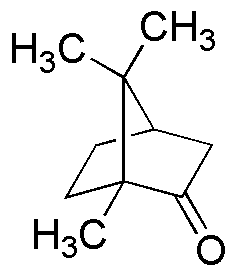(+)-Camphor is widely utilized in research focused on various applications across multiple industries. Here are five practical uses:
- Pharmaceuticals: Commonly used in topical analgesics and ointments, (+)-Camphor provides relief from pain and inflammation, making it a staple in pain management products.
- Cosmetics: Its aromatic properties make it a popular ingredient in perfumes and skincare products, where it acts as a fragrance and a skin-conditioning agent.
- Food Industry: Employed as a flavoring agent, (+)-Camphor enhances the taste of certain products, particularly in traditional cuisines, while also serving as a preservative due to its antimicrobial properties.
- Traditional Medicine: Used in various cultures for its therapeutic effects, it is often found in herbal remedies aimed at treating respiratory issues and improving circulation.
- Industrial Applications: In the manufacturing sector, (+)-Camphor is utilized as a plasticizer in the production of certain plastics, enhancing flexibility and durability.
These applications highlight the versatility of (+)-Camphor, making it a valuable compound in both consumer products and industrial processes.
General Information
Properties
Safety and Regulations
Applications
(+)-Camphor is widely utilized in research focused on various applications across multiple industries. Here are five practical uses:
- Pharmaceuticals: Commonly used in topical analgesics and ointments, (+)-Camphor provides relief from pain and inflammation, making it a staple in pain management products.
- Cosmetics: Its aromatic properties make it a popular ingredient in perfumes and skincare products, where it acts as a fragrance and a skin-conditioning agent.
- Food Industry: Employed as a flavoring agent, (+)-Camphor enhances the taste of certain products, particularly in traditional cuisines, while also serving as a preservative due to its antimicrobial properties.
- Traditional Medicine: Used in various cultures for its therapeutic effects, it is often found in herbal remedies aimed at treating respiratory issues and improving circulation.
- Industrial Applications: In the manufacturing sector, (+)-Camphor is utilized as a plasticizer in the production of certain plastics, enhancing flexibility and durability.
These applications highlight the versatility of (+)-Camphor, making it a valuable compound in both consumer products and industrial processes.
Documents
Safety Data Sheets (SDS)
The SDS provides comprehensive safety information on handling, storage, and disposal of the product.
Product Specification (PS)
The PS provides a comprehensive breakdown of the product’s properties, including chemical composition, physical state, purity, and storage requirements. It also details acceptable quality ranges and the product's intended applications.
Certificates of Analysis (COA)
Search for Certificates of Analysis (COA) by entering the products Lot Number. Lot and Batch Numbers can be found on a product’s label following the words ‘Lot’ or ‘Batch’.
*Catalog Number
*Lot Number
Certificates Of Origin (COO)
This COO confirms the country where the product was manufactured, and also details the materials and components used in it and whether it is derived from natural, synthetic, or other specific sources. This certificate may be required for customs, trade, and regulatory compliance.
*Catalog Number
*Lot Number
Safety Data Sheets (SDS)
The SDS provides comprehensive safety information on handling, storage, and disposal of the product.
DownloadProduct Specification (PS)
The PS provides a comprehensive breakdown of the product’s properties, including chemical composition, physical state, purity, and storage requirements. It also details acceptable quality ranges and the product's intended applications.
DownloadCertificates of Analysis (COA)
Search for Certificates of Analysis (COA) by entering the products Lot Number. Lot and Batch Numbers can be found on a product’s label following the words ‘Lot’ or ‘Batch’.
*Catalog Number
*Lot Number
Certificates Of Origin (COO)
This COO confirms the country where the product was manufactured, and also details the materials and components used in it and whether it is derived from natural, synthetic, or other specific sources. This certificate may be required for customs, trade, and regulatory compliance.


